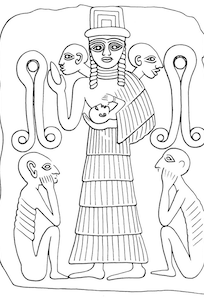
Not a Friend of ASOR yet? Sign up here to receive ANE Today in your inbox weekly!

December 2023
Vol. 11, No. 12
A Girl’s Helping Hand on the Journey to the Afterlife: Alabaster Ishtar-Aphrodite Figurines from Seleucid-Parthian Babylonia
By Stephanie M. Langin-Hooper
Sometime late in the Seleucid or early in the Parthian period (c. 2nd century BCE), a family living in or near Babylon grieved the death of five of its members. They were buried in individual tombs in a vault on the outskirts of the city, in what is modern-day Hillah. Terracotta masks guarded their tombs, with clay lamps deposited at the vault entrance and other vessels placed inside along with a rich assortment of objects such as seals and jewelry. Four of the deceased individuals — likely two adult women, an adolescent girl, and a child — were accompanied into the grave by anthropomorphic figurines made of alabaster. The figurine of a standing nude goddess with jointed arms wearing a crescent crown (Figure 1) was positioned next to the head of the adolescent girl.
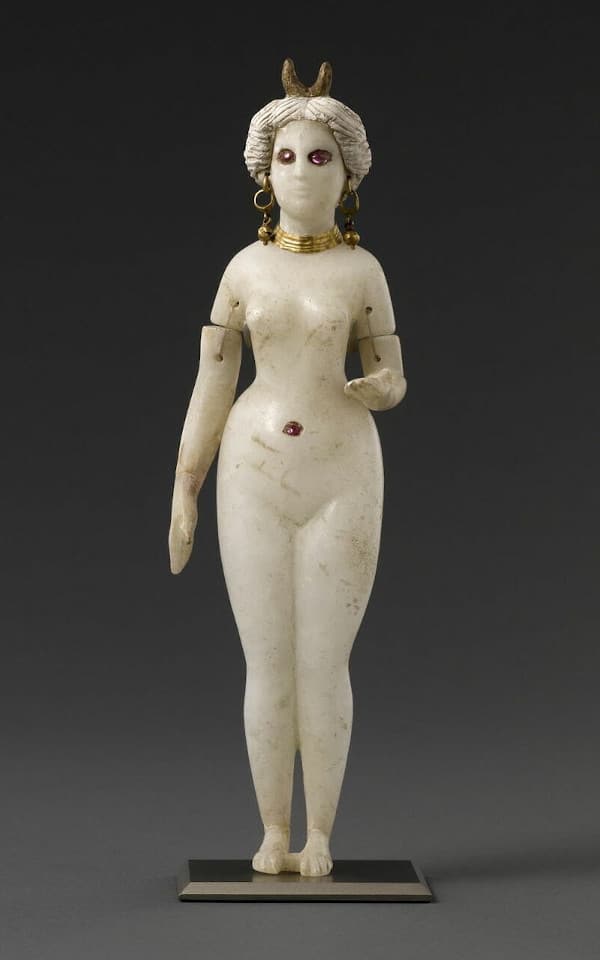
Few artworks from Seleucid-Parthian Iraq are as famous today as this alabaster goddess figurine, whose bright ruby eyes and gold crescent headdress have advertised blockbuster exhibitions and graced book covers in recent years.
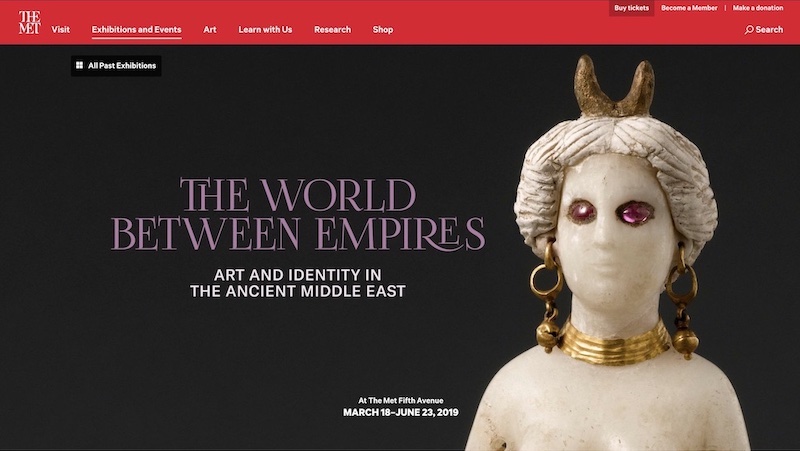
The preciousness of its materials and the figure’s divine status signaled by the crescent crown set this artwork apart from the vast majority of figurines made in Babylonia during this time, which are mostly terracotta representations of more ordinary human figures. Yet certain characteristics link this spectacular figurine and other alabaster goddesses of her type to terracotta figurines of this period.
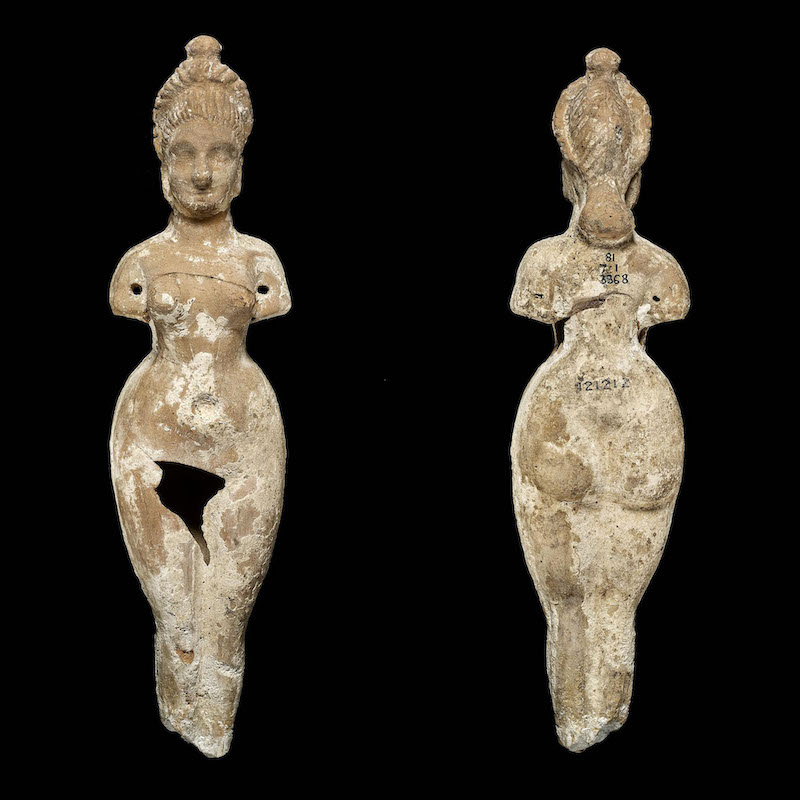
As seen in Figure 3, there are terracotta figurines of nude standing women with a very similar body type, pose, style, and — most crucially — separately-modeled and jointed lower arms. The most significant difference is that the terracotta figurines do not have crescent crowns, which is likely due to the fact that the crescent moon was a direct link to the practice of astronomy and astrology in the Babylonian temples. The wealthy elite of Seleucid-Parthian Babylonia may have been comfortable associating their personal figurines with official temple practice, but the average person, who could only afford terracotta, seems to have been either unable or unwilling to directly display such a connection. Thus, as I have recently argued in an article in the American Journal of Archaeology, the alabaster goddesses represent just the most elite and explicitly divine version of a common figurine type that was used by women and girls to connect with the goddess Ishtar-Aphrodite.
These figurines — both terracotta and alabaster — were new to Babylonia in the Seleucid period and seem to be local inventions used almost exclusively in this region. The style is striking: the soft contours of the facial features and the silhouette echo Greek statuary, while the large eyes and frontal posture derive from Babylonian figurine traditions. This blend of styles is evidence of the multicultural hybridity common to the figurines of Seleucid-Parthian Babylonia and suggests that this goddess was a syncretized combination of a Greek and Mesopotamian deity. The figurine’s nudity and assertive frontality suggest the goddesses of sex (Greek Aphrodite and Mesopotamian Ishtar) as the most likely candidate. The material features of these figurines — narrow waists and wide hips, which fit easily into the human hand; the smooth surface textures of fine-particulate clay or polished alabaster and bone, which invite lingering and repetitive caresses; the inability of these figurines to stand alone on their tiny feet — all suggest that these figurines were touched and held. The owner of such a figurine would gain intimate, haptic knowledge of the goddess’s nude body.
The best precedent for the alabaster goddesses, particularly the fragmentation of their arms, comes from Greek figurines that depict women’s torsos and heads with limbs truncated below the shoulder and above the knee. Greek grave reliefs depict young women and girls holding or contemplating such figurines (Figure 4).
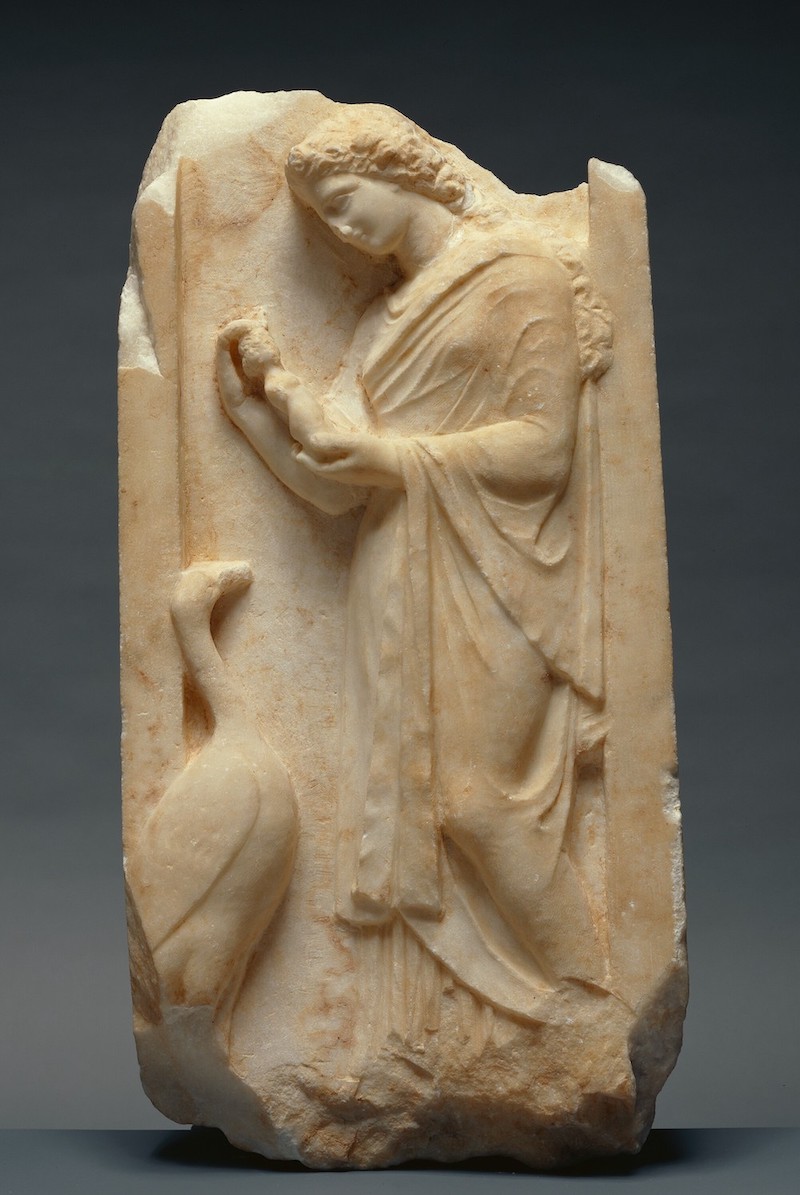
In her essay “Naked and Limbless”, Joan Reilly argues that these figurines were used as a form of anatomical votive for Greek girls to pray for, as well as learn about, the ideal sexual and reproductive form of the mature female body which they would hope to achieve through puberty. While the alabaster goddesses are similar to the Greek figurines, their bodies are more complete, with full legs and jointed arms. This suggests that the Babylonian figurines constructed a more active ideal of erotic agency, which combined the purpose of the Greek votives with the Mesopotamian concept of kuzbu, an Akkadian term for erotic allure and sexual vitality.
Yet, even as these figurines appear whole and mobile, their arm joints are actually quite stiff, only allowing a limited range of twisting motions. This too can be explained by the ideals of eroticism and sexuality that these figurines embodied. Inflexibility is often referred to in Hellenistic poetry as a feature of ideal erotic attraction, wherein the lover is rendered temporarily paralyzed by their desire for the beloved. In Idyll II by Theocritus, the female narrator Simaetha sees her lover cross the threshold of her home and all her “lovely flesh became as stiff as a doll’s” (Fowler 1990, p. 11). The alabaster goddesses embodied this experience in figurine form. Because their arms were jointed – appearing to offer the possibility of movement – their inflexibility would have been difficult to ignore as typical of clay or stone figurines in general. Rather, it was an intentional stiffness, one which became most noticeable during tactile interaction with the figurine when the user’s caressing and curious fingers might attempt to move the arm only to discover that it barely wiggles. This sexually charged paralysis might have been read as both role model and erotic response. The girl living in Seleucid-Parthian Babylonia who owned the alabaster goddess was empowered to think of herself as possessing both erotic attractiveness and sexual agency. She was a lover, the figurine implied, or she would be someday, capable of being paralyzed with erotic attraction but also with the power to seduce another person and make their body stiff with longing. The powerful goddess of sex, Ishtar-Aphrodite, would guide and bless her through the entire experience.
If a girl in Seleucid-Parthian Babylonia did not live long enough to fulfill the ideal of healthy adult sexuality and eroticism, then the goddess Ishtar-Aphrodite could accompany her into the grave. When these figurines were deposited in graves, they were often placed close to the body of the deceased, such as near the head or on the chest of the dead person. This shared bodily intimacy between a deceased young woman and her figurine suggested that the bond between them would not end at the tomb. Here, the animacy of the goddess figurines’ flexible arm joints might have had one last role to play: unlike the rigid immobility of the corpse, the slightly looser wiggling of the alabaster figurine offered the possibility of eternal movement that eclipsed death itself. The reaching gesture of the goddess’s extended arm may have even offered a “helping hand” to guide the girl to a happy afterlife.
Ishtar was considered an especially useful guide and protector for the deceased because, in Mesopotamian mythology, she once visited the underworld herself. In the myth of “The Descent of Ishtar”, the titular goddess tries unsuccessfully to conquer the underworld from her sister, Ereshkigal, who was its queen. Ishtar is required to stop and remove an item of personal adornment at each of the underworld’s seven gates: the Great Crown on her head (first gate), rings in her ears (second gate), beads around her neck (third gate), toggle-pins at her breast (fourth gate), girdle of birth stones at her waist (fifth gate), bangles on her wrists and ankles (sixth gate), garment of her body (seventh gate). When Ishtar arrives in the underworld fully naked, she is powerless and thus can be killed – a death from which Ishtar is only rescued when the gods send a substitute in her place. The Seleucid-Parthian Babylonian figurines offer a close corollary with this description of Ishtar’s adornment. Four of the jewelry items – the crown, earrings, necklace, and stone at the waist – appear on many of the alabaster figurines, while some terracotta examples also depict bangles on the ankles (see Figure 5).
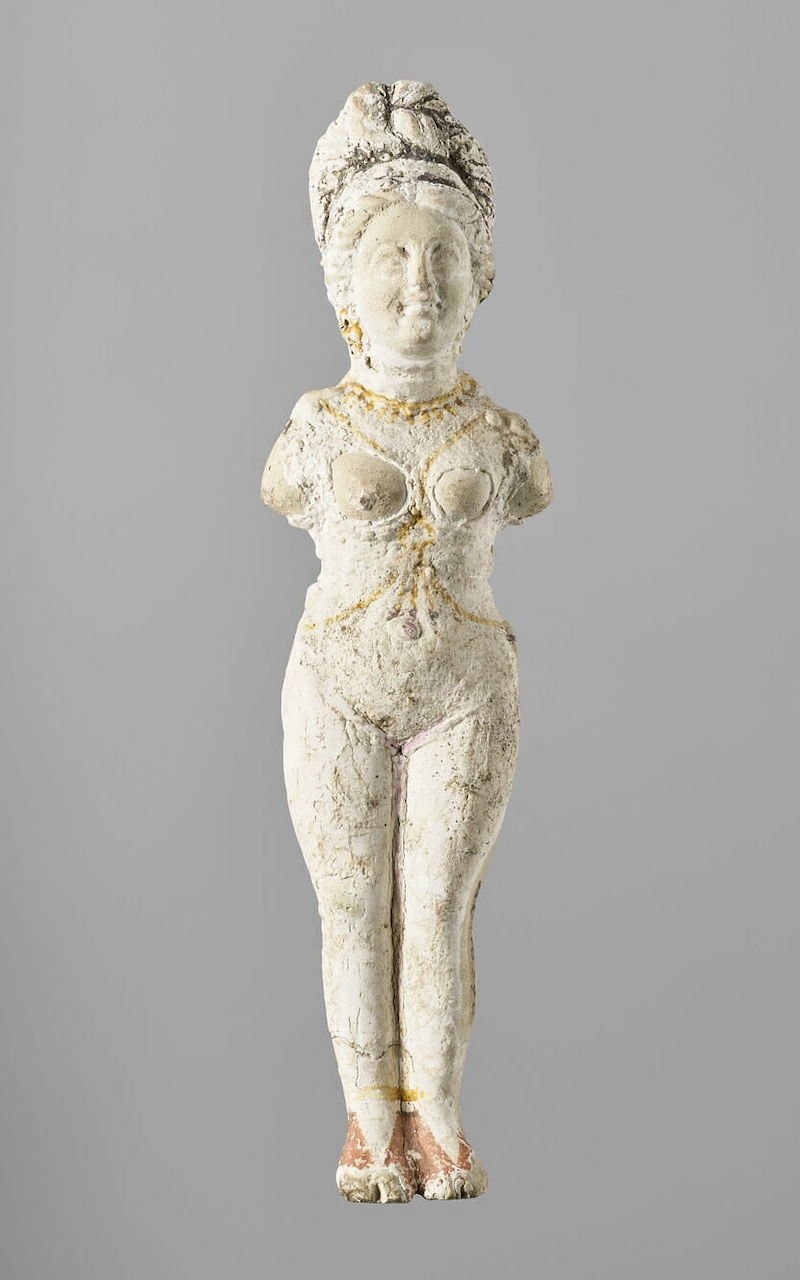
Because Ishtar is not completely naked in these figurines then, following the logic of the myth, she is not completely powerless. Instead, she might be on her way out of the underworld when her jewelry and clothing are restored to her, and she is able to escape death. Caitlín Barrett argues that this liminality of Ishtar, suggestive of underworld visitation but also of escape, was why the goddess had been so appealing to Mesopotamian people as they buried their dead for millennia. The Mesopotamian hymn “Ishtar, Queen of Heaven” refers to this power as being in her exclusive domain:
“No one but she can
Bring back the one who reveres her from the grave.
No one but she can
Revive the dead, restore […]” (Foster 2005, p. 594)
It is notable that, just as in the figurines, this hymn invokes Ishtar’s astral associations, as “queen of heaven”, connecting her to the moon and stars. This would have been particularly powerful in a funerary context, implying that the dead girl buried with a figurine of Ishtar-Aphrodite might similarly surpass the earthly realm and find her final destination in the bright heavens, which was the afterlife of choice in Hellenistic philosophical thought. Perhaps the moon would shine brightly next to her head too, just as the crescent sparkles atop the hair of the alabaster goddess.
Stephanie M. Langin-Hooper is Associate Professor and Karl Kilinski II Endowed Chair of Hellenic Visual Culture in the Department of Art History at Southern Methodist University. Her article, “Burying the Alabaster Goddess in Hellenistic Babylonia: Religious Power, Sexual Agency, and Accessing the Afterlife through Ishtar-Aphrodite Figurines from Seleucid-Parthian Iraq,” was recently published in the American Journal of Archaeology.
Further Reading
Barrett, C. 2007. Was dust their food and clay their bread? Grave goods, the Mesopotamian afterlife, and the liminal role of Inana/Ishtar. Journal of Ancient Near Eastern Religions 7(1): 7–65.
Foster, B. 2005. Before the Muses: An Anthology of Akkadian Literature. 3rd ed. CDL Press.
Fowler, B.H. 1990. Hellenistic Poetry: An Anthology. University of Wisconsin Press.
Fowlkes-Childs, B. and M. Seymour. 2019. The World Between Empires: Art and Identity in the Ancient Middle East. The Metropolitan Museum of Art. (open access!)
Graff, S. 2014. “Sexuality, Reproduction and Gender in Terracotta Plaques from the Late Third-Early Second Millennia BCE.” In Critical Approaches to Ancient Near Eastern Art, edited by B. Brown and M. Feldman, 371-90. De Gruyter.
Harris, R. 1991. “Inanna-Ishtar as Paradox and a Coincidence of Opposites,” History of Religions 30(3): 261-78.
Invernizzi, A. 2008. “Les Dominations Grecque et Parthe: 331 av. J.-C. – fin du 1er siècle apr. J.-C.” In Babylone, edited by B. André-Salvini, 251-92. Musée du Louvre Éditions.
Langin-Hooper, S.M. 2020. Figurines in Hellenistic Babylonia: Miniaturization and Cultural Hybridity. Cambridge.
Langin-Hooper, S.M. 2023. “Burying the Alabaster Goddess in Hellenistic Babylonia: Religious Power, Sexual Agency, and Accessing the Afterlife through Ishtar-Aphrodite Figurines from Seleucid-Parthian Iraq,” American Journal of Archaeology 127.2: 209-240. https://www.journals.uchicago.edu/doi/10.1086/723488
Mihai, A. 2018. “Hades in Hellenistic Philosophy (The Early Academy and Stoicism).” In Round Trip to Hades in the Eastern Mediterranean Tradition, edited by G. Ekroth and I. Nilsson, 194-214. Brill.
Reilly, J. 1997. “Naked and Limbless: Learning about the feminine body in ancient Athens.” In Naked Truths: Women, Sexuality, and Gender in Classical Art and Archaeology, edited by A. Koloski-Ostrow and C. Lyons, 154-73. Routledge.
Rochberg, F. 2004. The Heavenly Writing: Divination, Horoscopy, and Astronomy in Mesopotamian Culture. Cambridge.
Tallon, F. 1999. “Les rubis d’Ishtar: étude archéologique.” In Cornaline et pierres précieuses: La Méditerranée, de l’Antiquité à l’Islam, edited by A. Caubet, 229-48. Musée du Louvre.
How to Cite this Article:
Langin-Hooper, S. M. 2023. A Girl’s Helping Hand on the Journey to the Afterlife: Alabaster Ishtar-Aphrodite Figurines from Seleucid-Parthian Babylonia The Ancient Near East Today 11.12. Accessed at: https://www.asor.org/anetoday/2023/12/alabaster-ishtar-aphriodite-figurines
Want To Learn More?
Gender in the Ancient Near East and Egypt
By Stephanie Budin
Sex and gender have become central topics of discussion in a wide variety of fields. What did the people of ancient Mesopotamia and Egypt think about these concepts? Read More
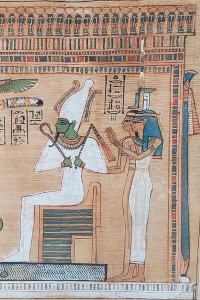 The Egyptian Conceptualization of the Otherworld
The Egyptian Conceptualization of the Otherworld
By Silvia Zago
As the place where the deceased continued living after death, the Duat is a core notion of Egyptian afterlife beliefs. But pinning down its features and location is no easy feat. Read More
